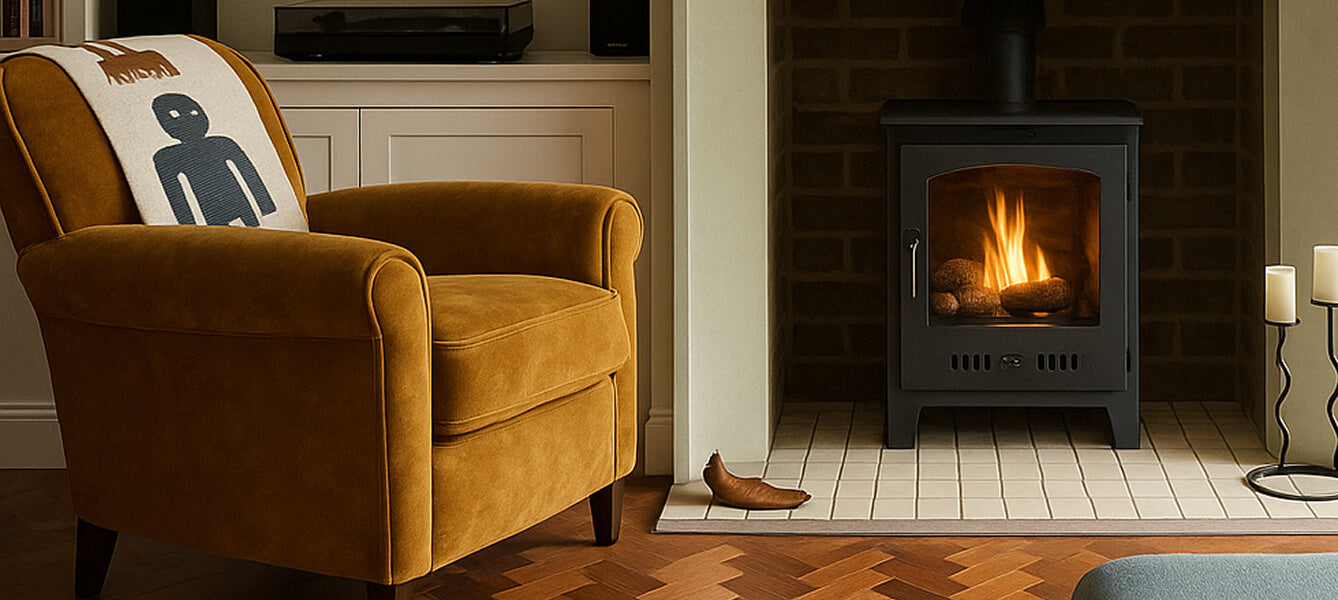
Smokeless Fuel: Which Is the Best Choice for Your Fire?
As the world wakes up to the potential health and environmental hazards of wood-burning stoves and open fires, many homeowners are starting to switch to fireplaces that run on smokeless fuel.
Of course, the turn away from smoky fires has left many wondering how they will keep their living rooms feeling warm and cosy without the familiar crackle of a fireplace. After all, a fireplace can transform a living room into a haven of warmth and sophistication. Fortunately, there are solutions out there to help you achieve the fireplace of your dreams while eliminating the production of smoke entirely.

Indeed, fireplaces that run on what is known as smokeless fuel are becoming increasingly popular in modern homes and come with a swathe of advantages over their more traditional counterparts.
Bioethanol fireplaces and gas fireplaces, for example, are smokeless fireplaces and can be installed quickly and easily without the need for a chimney and without compromising on style. In this brief guide, we set out your fuel options if you are thinking of installing a smokeless fire with smokeless fire logs.
What is smokeless fuel?
Smokeless fuels include the various types of fuel that only produce very small amounts of smoke when burned. Types of smokeless fuel include, for example, bioethanol and smokeless coal, both of which we will take a deeper look at in this brief guide.
Why should I be using smokeless fuel & smokeless fireplace?
Smokeless fuel is a much safer alternative to smoke-producing fuel, particularly wet wood. Wood-burning open fires and stoves produce a range of toxic gases and particulate matter (PM) that can increase a person’s risk of developing heart and lung diseases.
Smoke from fireplaces is particularly dangerous for people with chronic illness, as well as the very old and very young.
What kind of smokeless fuel do I opt for: best fuel for log burners, open fires and more
Ultimately this depends on the model of your fireplace and what you hope to get out of it. By opting for a biofire such as one of the many gorgeous models offered by Imaginfires, you can enjoy a range of benefits by using bioethanol fuel. These include:
- The option to buy scented biofuels to make your living room smell amazing
- Much lower carbon dioxide emissions compared to other fuels
- Biofires do not come with a flue and are totally ash- and smoke-free
- Biofires are easy to install and very easy to use
- Burning bioethanol does not produce harmful PM
- Biofireplaces come in a range of modern styles that will fit right into your living room (free-standing, woodburner style, and more)
If you are looking for a slightly more efficient fire than those produced by bioethanol, you may want to opt for a fireplace capable of burning smokeless coal. Although it does not boast the same amazing health and environmental benefits as biofuel, it tends to burn with a stronger flame and for a longer duration.
Is smokeless fuel really smokeless?
Technically speaking, smokeless fuel can generate small amounts of emissions. However, another advantage of smokeless fuel is that fumes from smokeless fuel are much less dangerous than those produced on wood-burning fireplaces and, therefore, are becoming the standard choice for homeowners around the country.
With biofuels, a very small quantity of carbon dioxide is released during the burning process. It is important to understand, however, that this quantity is equivalent to how much carbon dioxide would be produced when burning a few tea lights.
Whilst much better for your health and the environment, however, it is a good idea to ensure that there is plenty of ventilation in the room in which you decide to install your biofire.
Is smokeless coal really smokeless?
Smokeless coal is slightly less impressive in terms of emissions than biofuel, although it is thought to be more efficient when it comes to generating warmth. Best smokeless coal generates around 80% less smoke compared to traditional coal and around 20% less carbon dioxide. It also produces fewer than five grams of smoke per hour, which is good news if you want to avoid the potentially nasty consequences of smoke inhalation and PM.
Can you use smokeless fuel in a wood burner?
It is very important to note that smokeless fuel should not be used in traditional wood-burning stoves and fireplaces. This is because burning anything other than logs in this kind of appliance can lead to serious damage and could even put you and your family at risk. Advantages of smokeless fuels, however, is to be used in multi-fuel appliances, including wood-burning stoves that have been converted into multi-fuel models.

It is also a good idea to take note of the fact that burning fuels that have not been approved by the manufacturer of your stove or fireplace can void any relevant guarantees. Remember to read the manual first if you are unsure about which kinds of fuel are suitable for burning or, failing that, get in touch with their customer service team and ask.
How can I tell which fuel is smokeless or gives least smoke?
If you choose to install a wall-mounted biofire, you can rest assured that all compatible fuels (such as the Imaginfires range) will be smokeless and effective. When it comes to smokeless coal for log burners, you can easily check whether it is smokeless by simply checking the information on the pack.
Smokeless fuel prices
Are you looking for the best smokeless fuel for your fireplaces whilst trying to stick to a budget? The good news is that smokeless fuels are widely available and generally very affordable. Of course, the amount that you end up spending will depend on how often you use your fireplace, how strongly you would like it to burn, and the type and model of your appliance.
To give you an idea of how much you will need to spend, bioethanol fuel ranges from around £2 to £5 per litre. Depending on how quickly you burn it, this will add up to an operating cost of between 50p and £1.25 per hour.
With smokeless coal, on the other hand, you can expect to pay between £5 and £15 for a 25kg bag. It may be slightly more expensive than biofuel, but it is sometimes the preferred option for those looking to generate a considerable amount of warmth and those who like to burn their fires for a longer period of time.
The best price on smokeless coal really depends on the availability of smokeless coal in your area and the specific type that you opt for. Indeed, there are a number of different types of smokeless coal, each with its own pros and cons.
Anthracite, for example, one of the more popular smokeless coals, provides a moderate heat with a minimal flame and leaves only residual ash. Phurnacite, on the other hand, offers very strong heat, meaning it is often used in cold living rooms and cookers.
Check out Imaginfires’ range of smokeless biofuels
Looking for some bioethanol fuel to get your biofire up and running? Look no further than Imaginfires’ amazing range of fuel bottles. Whether you’re looking for vanilla- or forested-scented varieties, or would rather opt for something with a low odour, we have the product for you. Our fuels come in packs of six or twelve bottles and represent excellent value for money.
